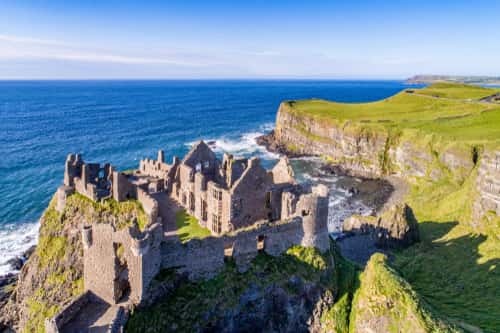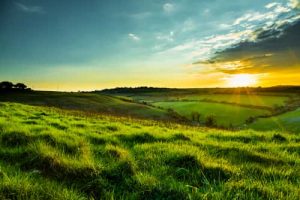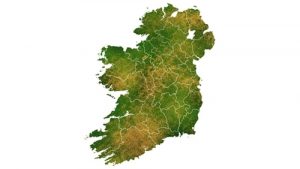The history of the country’s name is long and drawn out. For starters, you should know that the country wasn’t always known as “Ireland.”
It’s believed that Ireland was first known as “Inis na Fidbadh,” which means “Isle of the Woods.” The name was given to the country by the Vikings, who were the first to stumble on the island. They also might have originally referred to Ireland as the “westland isle.”
It was also believed that the earliest Celts may have originally referred to Ireland as the “Abundant Land.” The Greeks and Romans, however, called the island “Hibernia,” which translates to “land of winter.” The name “Hibernia” is still frequently used by organizations and companies throughout Ireland today.
It’s thought that the word Ireland originated from the old Irish word Éire,” which stems from Ériu, who was a Gaelic goddess. According to Irish mythology, Ériu was believed to be the Goddess of the island, as well as the Goddess of sovereignty.
Have you ever wondered where Ireland’s name came from?
The Germanic word “land” was added to the end of “Ire” to make up Ireland.” Given the strong pagan beliefs that have historically run rampant through Ireland, this theory seems extremely likely.
Ireland’s Capital Was Named by Vikings Dublin is the capital of Ireland. It might surprise you to learn that the city wasn’t named by the Irish but instead by the Vikings.
During the 8th and 9th centuries, the Vikings raided Ireland. They established a settlement, which they called Dubh Linn, which translate to “black pool.” They named the settlement after the lake where they anchored their boats.
They also referred to their settlement as the “Norse Kingdom of Dublin.” It might surprise you to learn that the Vikings also ruled over Dublin for nearly 700 years.
Their rule came to an end in 1169 when the Mac Murrough, King of Leinster, asked for the help of Strongbow, the Earl of Pembroke, to conquer Dublin. After the King’s death, Strongbow declared himself the King of Leinster. He then went on to defeat both the Vikings and the High King of Ireland.
However, Strongbow’s rule over Ireland didn’t last long. The King of England feared that Strongbow would become too powerful. The King of England declared himself Lord of Ireland. As a result, Dublin was given to the merchants of Bristol, England.
Why is Ireland Called the Emerald Isle?
Ireland’s nickname, the Emerald Isle, might lead you to think that the gemstone is mined in the state. Sorry to be the bearer of bad news, but there are no emerald mines in Ireland. So, how did the country get its name?
Ireland’s greenery plays a huge role in why it’s been dubbed the Emerald Isle. If you have ever flown above the country, then its nickname will make perfect sense. But, ultimately, we can thank poet William Drennan for the nickname.
Drennan was the first to ever refer to Ireland as “the Emerald Isle” in his 1795 poem, which was titled When Erin First Rose. It’s unknown if someone else might have originally coined the term, but Drennan was the first one to have ever used it in print, so he’s generally credited with giving Ireland its famous nickname.
Why is Ireland is Divided into the Two Parts of Ireland?
You may already know that Ireland is divided into Northern Ireland and the Republic of Ireland. Have you ever wondered why this is?
The split occurred during the Partition in 1921. Formally known as the Government of Ireland Act 1920, the partition was designed to create two self-governing territories in Ireland. Both of the territories were intended to remain within the United Kingdom.
The Act of 1920 had provisions that would eventually reunite the two territories. The Easter Rising also played a key role in the divide. The Easter Rising, which is also commonly referred to as the Uprising of 1916 or the Easter Rebellion, is one of the most significant events to have ever taken place in the history of Ireland.
On Easter Week in April of 1916, the Rising was started by Republicans in Ireland who wanted to end British rule in the country.
Their goal was to form an independent Irish Republic. They thought it was a good time to rise against the United Kingdom, since it was already very much engaged in World War I.
The Uprising of 1916 lasted for six days, beginning on Easter Monday. It was led by Patrick Pearse, who was a schoolmaster and Irish language activist. He was joined by James Connolly’s smaller Irish Citizen Army, as well as 200 women.
They seized locations throughout Dublin and proclaimed an Irish Republic.
The British Army brought in thousands of reinforcements. In addition to having higher numbers, the British Army also had heavier weapons. They were able to stop the Rising.
They also made approximately 3,500 Irish people prisoners, many who had no role in the Rising. About half of those were sent to internment camps or prisons in Britain.
The Easter Rising ultimately led to the Irish War of Independence. The war was fought between the years of 1919 and 1921. The war resulted in the Anglo-Irish Treaty. The treaty allowed the southern part of Ireland to become a free state. It called itself the Republic of Ireland. The treaty said that Northern Ireland could opt out of the Irish free state, which it did.
Northern Ireland remained a part of the United. Kingdom, which it is to this day. The Republic of Ireland, which is often just referred to as “Ireland,” remains independent to this day.
Northern Ireland and the Republic of Ireland are considered to be the same country. The two are considered different territories or states, however.
There has been talk over the years of Northern Ireland and the Republic of Ireland reuniting again to form one country again.


